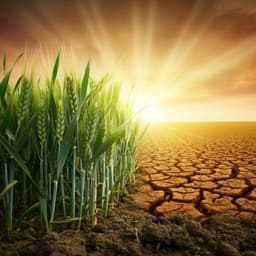
Agriculture
Microbially mediated mechanisms underlie soil carbon accrual by conservation agriculture under decade-long warming
J. Tian, J. A. J. Dungait, et al.
Discover how switching to conservation agriculture can boost soil organic carbon levels, even in a warming climate! This groundbreaking research by Jing Tian, Jennifer A. J. Dungait, Ruixing Hou, Ye Deng, Iain P. Hartley, Yunfeng Yang, Yakov Kuzyakov, Fusuo Zhang, M. Francesca Cotrufo, and Jizhong Zhou reveals the nuanced interactions between agricultural practices and microbial dynamics.
~3 min • Beginner • English
Introduction
Soil organic carbon (SOC) provides critical ecosystem services but has been depleted in croplands through inappropriate management. Conservation agriculture (CA)—residue retention with no or reduced tillage—has potential to rebuild SOC, yet SOC is vulnerable to warming-driven decomposition. The interactive effects of warming and management on SOC accrual in croplands remain scarce. Microbial processes, particularly microbial carbon use efficiency (CUE) and necromass formation, are central to SOC stabilization and may acclimate over time to warming and management. This study uses a decade-long field experiment in a wheat–maize system to test how warming (+2 °C) interacts with CA versus conventional agriculture (ConvA; residue removal, annual tillage) to affect SOC accrual and persistence. The authors hypothesized that under warming: (i) CA increases SOC directly via greater plant carbon inputs and indirectly by enhancing substrate availability to microbes; (ii) microbial adaptation under CA increases CUE and necromass contributions to SOC over time; and (iii) increased fungal community size and accelerated turnover boost fungal necromass accumulation, promoting SOC formation and persistence.
Literature Review
The paper reviews evidence that SOC typically accumulates following shifts from intensive tillage to conservation practices, though responses vary by region and time. Warming generally enhances decomposition rates and may threaten SOC, particularly in soils with larger unprotected pools such as particulate organic matter. Short-term incubation studies have shown mixed results for SOC mineralization differences between CA and conventional systems under warming. Microbial CUE, influenced by temperature, moisture, substrate availability, and community composition, is pivotal for SOC formation via microbial biomass and necromass pathways. Fungi often exhibit higher CUE than bacteria but are sensitive to tillage and warming; conservation practices can enhance microbial CUE and necromass by improving moisture and substrates and reducing disturbance. However, long-term, in situ evidence linking management-warming interactions, microbial physiology, community succession, and SOC accrual has been limited.
Methodology
Experimental site and design: A long-term field experiment (initiated 2003) at Yucheng Comprehensive Experiment Station, North China (36°51′N, 116°34′E; temperate semi-arid; mean T=13.1 °C; 561 mm precipitation; silt loam; pH 7.1; Calcaric Fluvisol) in a double-cropped winter wheat–summer maize system. Factorial treatments (randomized complete block, n=4 per treatment, plot 2 m × 2 m): conservation agriculture with and without warming (residues chopped ~5 cm and retained; no tillage) and conventional agriculture with and without warming (residues removed; annual rotary tillage 10–15 cm). Infrared heaters imposed +2 °C soil warming from 2010–2020 (heaters ~3 m height; Kalglo MSR-2420). Crop calendar: wheat October–June; maize June–September.
Measurements and sampling: Soil temperature (5 cm; PT 100 thermocouples) and volumetric moisture (0–10 cm; FDS100) continuously monitored. Aboveground biomass harvested annually (2 m × 2 m). Root biomass and in situ root exudation C measured Oct 2019–May 2020 with a cuvette system and TOC analysis. Soils (0–5 cm) sampled biennially post-wheat harvest in 2010, 2012, 2014, 2016, 2018, 2020; five cores composited per plot; subsamples air-dried, 4 °C, and −80 °C stored.
Soil chemistry and microbial traits: SOC and total N by dry combustion (Elementar Vario EL III). DOC in fresh soils per Jones & Willett. Microbial CUE, growth, respiration, and C uptake measured in 2021 on −80 °C archived samples using substrate-independent 18O-H2O tracer after 7-day preincubation (40–60% field capacity, 20–25 °C); CO2 quantified by GC; DNA 18O enrichment by EA-IRMS; CUE = C_growth / (C_growth + C_respiration). Microbial biomass and community groups via PLFA (2020). Microbial necromass C via amino sugar biomarkers (glucosamine, galactosamine, muramic acid) after 6 M HCl hydrolysis and GC-FID; fungal and bacterial residue C calculated using established conversion factors; total necromass = fungal + bacterial residues.
Microbial communities and functions: DNA extracted (PowerSoil). Amplicon sequencing: bacteria (16S V4–V5, F515/R907), fungi (ITS, gITS7F/ITS4R); quality filtering; ASVs via UNOISE3; taxonomy with SILVA and UNITE. Metagenomics (2010 and 2020 samples): DNA fragmented (~400 bp), libraries (NEXTFLEX Rapid DNA-Seq), NovaSeq sequencing; reads filtered with fastp; assembly with MEGAHIT; gene annotation using DIAMOND against KEGG; CAZy annotation via hmmscan; abundances normalized as RPM.
Statistical analyses: Repeated-measures mixed-model ANOVA for management, warming, year, and interactions; LSD post hoc tests. Linear regressions for temporal trends and effect sizes (Cohen’s d) comparing warmed vs ambient within management. Community analyses: PCA; ADONIS, ANOSIM, MRPP; linear mixed-effects models for taxa (Wald χ² tests). Time–decay relationships (TDRs) to quantify temporal turnover (slopes). Response ratios for functional genes (ln Xt/Xc). Structural equation modeling (SEM; AMOS 23) for SOC drivers including temperature, substrate availability (plant biomass, DOC), microbial diversity, community structure, CUE, and necromass; model fit by χ²/df and GFI.
Key Findings
- SOC response: Over 10 years, CA increased SOC relative to conventional, regardless of warming. Warming further increased SOC under CA by 3.1% vs ambient (p<0.05), with significant management × warming and management × warming × year interactions. The warming effect on SOC under CA strengthened linearly and accelerated after year 5 (2016–2020; p=0.006), while no significant warming effect occurred under conventional management.
- Microclimate and plant inputs: Warming increased soil temperature and reduced moisture in both systems, but CA plots were cooler and wetter under warming due to residue cover. Warming increased aboveground biomass under CA only (p<0.05). Warming increased root biomass and root exudation in both systems; under CA, total root C input rose by 65% under warming vs ambient, coinciding with higher SOC and DOC.
- Microbial physiology: Under CA, warming increased microbial CUE by 12%, growth by 43%, and carbon uptake by 24% across years (p<0.05). Warming effects on CUE under CA increased linearly over time (slope ~0.83; p=0.01), with early negative and later positive responses; during 2016–2020, warming increased CUE by 1.1–1.5×. Growth and C uptake differences between warmed and ambient under CA also increased over time (slopes ~0.58 and 0.44; p<0.05). No significant effects under conventional management.
- Necromass and contribution to SOC: Under CA, warming raised total microbial necromass C by 77% vs ambient (p<0.05) and fungal necromass by 29%. Contributions to SOC under CA increased from 2010 to 2020: total necromass from 33% to 61% and fungal necromass from 28% to 53%. The warming effect size on fungal necromass grew ~19-fold from 2010 to 2020 (slope ~1.6; p=0.04).
- Microbial communities and turnover: Warming altered bacterial and fungal community composition (ADONIS/ANOSIM/MRPP p<0.05) with management dependence. Under CA, warming decreased fungal phylotype richness by 9.3–12% in 2016–2020. Taxonomic shifts under CA with warming included decreased Acidobacteria (β = −0.122, p<0.001) and increased Actinobacteria, Firmicutes, Bacteroidota, and Verrucomicrobiota (p<0.05). Ascomycota showed stronger positive warming response under CA (β=0.026) and shifted from negative early (β=−0.034) to positive later (β=0.085). Saprotrophs marginally increased, more under CA (p=0.015 vs 0.055). Temporal turnover (TDR slopes) was steeper for fungi than bacteria and increased under CA with warming; divergences between warmed and ambient communities grew linearly over time under CA, especially for fungi.
- Functional genes: Early (2010), warming decreased biosynthesis-related pathways under both managements and increased ligninolytic genes while decreasing pectin, cellulose, and chitin degradation genes. Later (2020), under CA with warming, biosynthesis pathways (biofilm formation, amino acid and fatty acid biosynthesis) increased; CAZy showed increased starch-degrading genes (+4.0%) but decreased pectin, cellulose, and chitin degradation genes. Under conventional management later, warming increased genes for starch (+0.76%), cellulose (+11%), chitin (+4.60%), and lignin (+6.77%) degradation.
- SEM: The model explained 85% of SOC variance. Fungal necromass had the strongest positive direct effect on SOC. Microbial CUE exerted strong positive effects on fungal necromass (path coefficient 0.64) and had indirect effects on SOC. Substrate availability directly shaped fungal community composition, which positively affected microbial growth and CUE (path coefficient ~0.47). CUE and necromass increased with genes linked to growth potential and decreased with carbohydrate-degrading gene abundances.
Discussion
The results show that conservation agriculture mediates warming impacts on soil microclimate and plant inputs, enabling SOC accrual under warming. Enhanced plant-derived carbon inputs and maintained soil moisture under CA supported microbial communities—particularly fungi—leading to increased microbial growth efficiency (higher CUE) and greater necromass formation. Temporal analyses revealed a pivotal shift after year 5: warming under CA progressively increased CUE, growth, and fungal necromass, aligning with rising plant inputs and SOC. Accelerated fungal community turnover and divergence under CA with warming indicate a dynamic, substrate-responsive fungal assemblage contributing disproportionately to SOC formation via necromass. Functional gene shifts toward microbial growth and reduced decomposition of recalcitrant substrates under CA further support efficient carbon processing. SEM confirmed fungal necromass as the dominant direct driver of SOC, with CUE and fungal community composition as key mediators linking substrate availability to stable SOC formation. Conversely, under conventional management, despite increased root inputs, warming enhanced genes for decomposition of both labile and recalcitrant carbon and did not translate to SOC gains, suggesting less efficient microbial carbon routing and potential vulnerability of SOC to loss.
Conclusion
Over a decade, conservation agriculture in combination with moderate warming (+2 °C) increased SOC accrual by fostering a microclimate and substrate regime that promoted higher microbial carbon use efficiency, accelerated fungal community turnover, and increased fungal necromass contributions to SOC. These microbially mediated mechanisms—enhanced growth efficiency, community succession, and necromass entombment—underpin persistent SOC formation under CA. The findings suggest that, particularly where water is not limiting, regenerative practices can effectively sequester carbon under warming, strengthening agricultural resilience and supporting climate-smart agriculture. Future research should test these mechanisms across diverse regions, soils, and precipitation regimes, and over longer timescales, to refine management strategies that maximize SOC persistence and ecosystem multifunctionality.
Limitations
Generalization may be constrained by site-specific conditions: semi-arid temperate climate, soil type, and a specific wheat–maize rotation with small experimental plots. Results are most applicable where water does not limit productivity; broader validation is needed across regions with varying precipitation and environmental contexts. The study calls for additional work to assess combined management–climate effects on SOC accrual and persistence across different agroecosystems.
Related Publications
Explore these studies to deepen your understanding of the subject.







